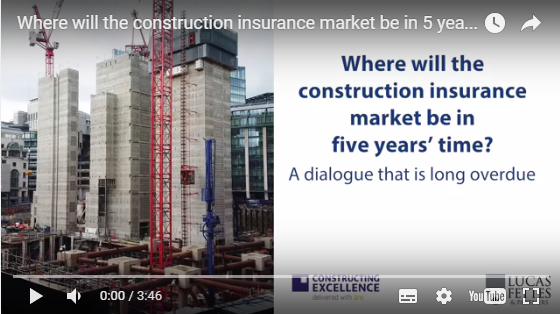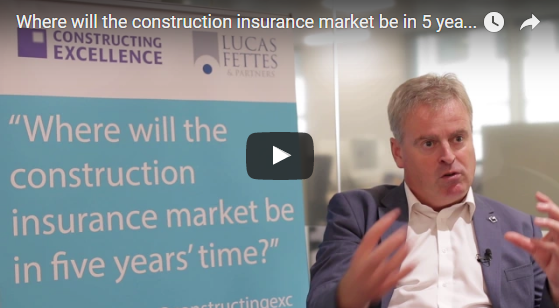Future of construction insurance
In 2016, a 'meeting of minds' was held with key players in the construction sector and leading construction insurers to discuss current trends and debate the future outlook for their respective industries.
The event was organised following a discussion between Lucas Fettes & Partners and Constructing Excellence.
Having been charged with driving the change agenda in construction, Constructing Excellence wished to explore with insurers the way in which new insurance models could be created to better align the interests of both the insurance and the construction industry. And in addition, whether there is potential for enabling more innovative and efficient funding frameworks in a way that would reduce risk and encourage more collaborative working.
As the construction sector changes, insurers are finding that their traditional products and underwriting techniques are in danger of becoming outmoded. Whilst many acknowledge the need to change, acting on this is a huge challenge, and the development of new approaches can only happen if there is effective collaboration between clients, investors, contractors and the insurance industry.
Building Information Modelling (BIM); new design and construction technology; a shift towards pre-manufacturing and off-site building; a shorter lifespan for built assets and improved data, all have ramifications – presenting opportunities and challenges in equal measure – for those who construct buildings, those who finance them, and those who manage the risks.
BRE produced a Youtube video entitled 'Where will the construction insurance market be in 5 years’ time?'
Some of the key insights that came out of the discussion include:
On any given project there are multiple insurers underwriting the same risk, resulting in significant over-insurance and driving behavioural norms towards a litigious rather than collaborative approach. Projects too often seem to be to be set up for a win-lose scenario. True collaboration can only come from the alignment of each party’s commercial needs.
An insurance product that caps out-turn costs could take away the potential for conflict by looking at how much can be priced in, instead of out, of cover. Again, success requires a shared commercial interest.
Connectivity and the Internet of Things may bring about an insurance product that extends beyond the build project and into the operational lifecycle of the building. If you can understand how a building is going to age, then it is possible to model this.
BIM creates the availability of tools to provide information – management information is readily accessible on a tablet or in app form. Will that drive different lending behaviours or create different types of lenders? New technological underwriting techniques will be a major disruptor, making it possible to bypass traditional means of insurance.
Technology is only ever an enabler. The maturity and competency of the client is critical. What is their track record? Do they have the right leadership? How much do they care? Just how invested are they in the project? Businesses that derive the most value will be those that invest in building BIM into their transformational programmes, such as health and safety and HR.
Data can be more valuable than the physical assets that underlie it. Competitive advantage does not come from holding on to your own data, but from sharing and pooling data, then competing on the ability to analyse and get value from it.
Underwriters must have a joint seat at the table with a client. Brokers have traditionally enjoyed being able to control the relationship but, now, a good broker will allow the insurer to get in front of the client.
BRE produced a Youtube video entitled 'Key insights from our roundtable discussion'.
Following the event, which was viewed as the start of a conversation that is long overdue, all parties involved agreed that there was scope for further exploration and development of some of the thoughts and ideas discussed.
The intention is to expand the conversation into a series of regional events, to continue to drive debate and encourage greater collaboration and innovation between the sectors.
Lucas Fettes and Constructing Excellence have published a report that covers these themes in more detail. This can be downloaded here.
The participants in the discussion were:
- Jonathan Smith – Head of Commercial SME Solutions & Schemes, Aviva
- Douglas Barnett – Head of Customer Risk Management, AXA Insurance
- Christian Taylor – Senior Legal Counsel, CNA Hardy
- Don Ward – Chief Executive, Constructing Excellence
- Adam Golden – Legal Executive, Costain Limited
- Paul Goulding – Head of Insurance, Heathrow Airport Limited
- Simon Middleton – Director, Protek Group Limited
- Nick Newlove – Construction Director, RSA Insurance
- Madoc Batcup – Managing Partner, Synaps Partners LLP (also Chair of Constructing Excellence Funding & Finance Group)
- Chris Ashmead – Regional Underwriting Manager, Tokio Marine HCC
- Paul Connolly – Managing Director, Turner & Townsend
This article was originally published by BRE Buzz on 6 Dec 2016. It was written by Ali Nicholl.
--BRE Buzz
[edit] Related articles on Designing Buildings Wiki
- BRE Buzz articles on Designing Buildings Wiki.
- Building Users’ Insurance Against Latent Defects.
- Contractors’ all-risk insurance.
- Contract works insurance.
- Directors and officers insurance.
- Employer’s liability insurance.
- Flood insurance.
- Insurance for building design and construction.
- Insurance terminology.
- Legal indemnity insurance.
- Professional Indemnity Insurance.
- Public liability insurance.
- Residual value insurance.
- Trade credit insurance.
Featured articles and news
Latest Build UK Building Safety Regime explainer published
Key elements in one short, now updated document.
UKGBC launch the UK Climate Resilience Roadmap
First guidance of its kind on direct climate impacts for the built environment and how it can adapt.
CLC Health, Safety and Wellbeing Strategy 2025
Launched by the Minister for Industry to look at fatalities on site, improving mental health and other issues.
One of the most impressive Victorian architects. Book review.
Common Assessment Standard now with building safety
New CAS update now includes mandatory building safety questions.
RTPI leader to become new CIOB Chief Executive Officer
Dr Victoria Hills MRTPI, FICE to take over after Caroline Gumble’s departure.
Social and affordable housing, a long term plan for delivery
The “Delivering a Decade of Renewal for Social and Affordable Housing” strategy sets out future path.
A change to adoptive architecture
Effects of global weather warming on architectural detailing, material choice and human interaction.
The proposed publicly owned and backed subsidiary of Homes England, to facilitate new homes.
How big is the problem and what can we do to mitigate the effects?
Overheating guidance and tools for building designers
A number of cool guides to help with the heat.
The UK's Modern Industrial Strategy: A 10 year plan
Previous consultation criticism, current key elements and general support with some persisting reservations.
Building Safety Regulator reforms
New roles, new staff and a new fast track service pave the way for a single construction regulator.
Architectural Technologist CPDs and Communications
CIAT CPD… and how you can do it!
Cooling centres and cool spaces
Managing extreme heat in cities by directing the public to places for heat stress relief and water sources.
Winter gardens: A brief history and warm variations
Extending the season with glass in different forms and terms.
Restoring Great Yarmouth's Winter Gardens
Transforming one of the least sustainable constructions imaginable.

























